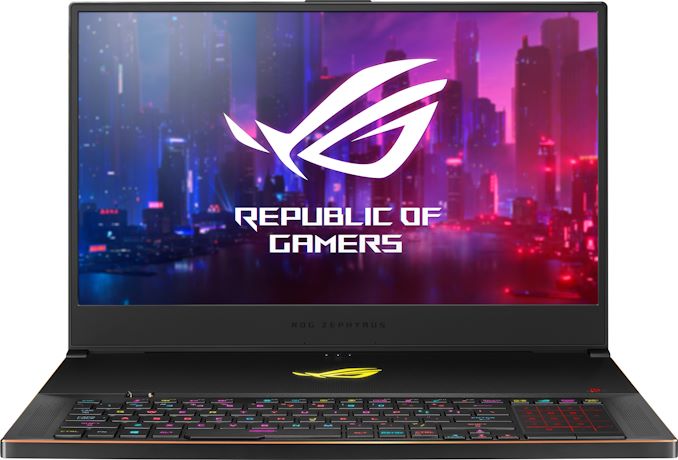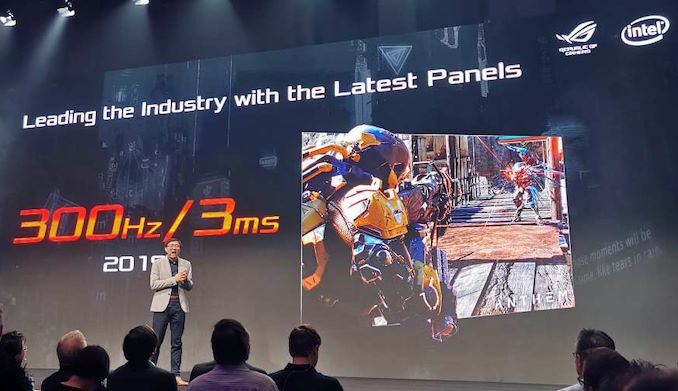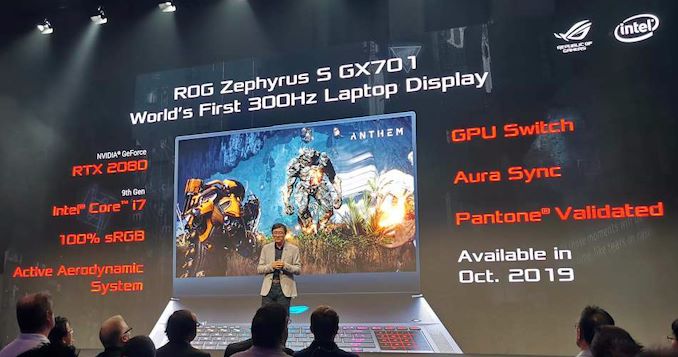It Hurtz a Lot: ASUS's New 300 Hz Laptops
by Anton Shilov on September 4, 2019 8:01 AM EST
ASUS has been at the forefront of using displays with extreme refresh rates with its ROG-series gaming laptops. The company was the first to launch notebooks with a 120 Hz LCD in 2016, was the first to release a mobile PC with a 144 Hz monitor, and then the first to produce a laptop with a 240 Hz earlier this year. At IFA, the company is demonstrating the industry’s first laptops featuring a display with a 300 Hz refresh rate.
Designed specifically for hardcore gamers and esports professionals on the go, the ASUS ROG Zephyrus S GX701 will be the world’s first notebook with a display supporting up to 300 Hz refresh rate and a 3 ms GtG response time. This machine will be available already in October, 2019. In addition, similar LCDs with a 300 Hz refresh rate and a 3 ms GtG response time will be featured on a prototype ROG Zephyrus S GX502 as well as on the 15-inch and 17-inch models of the ROG Strix Scar III.
ASUS does not disclose the maker of its 300 Hz/3 ms display panels, though it is highly likely that the company uses panels with a 240 Hz native refresh rate in overdrive mode. What is noteworthy is that production 240 Hz ROG Zephyrus S GX701 and ROG Zephyrus S GX502 will feature factory-calibrated displays with Pantone Validation, so in addition to gamers, these machines will also be appreciated by professionals who use color-critical applications.
When it comes to other hardware used by the forthcoming 300 Hz laptops and other premium mobile gaming PCs from ASUS, the company says that the flagship ROG Zephyrus S GX701 will come with NVIDIA’s GeForce RTX 2080 GPU clocked up to 1230 MHz at 100W in Turbo mode. Meanwhile, on display will be prototyes of the ROG Zephyrus S GX502 as well as the 15-inch and 17-inch flavors of the Strix Scar III with the 300 Hz display which will use NVIDIA’s GeForce RTX 2070 GPU with up to 1540 MHz GPU clock at 115W in Turbo mode. Given usage of NVIDIA's graphics processors, the laptops will also support G-Sync variable refresh rate. As these are just prototypes, it will be interesting to see if these make it to market.
As for other specifications of the new ROG Zephyrus S-series laptops will pack up to Intel's six-core Core i7-9750H processor accompanied by up to 32 GB of DDR4-2666 as well as an NVMe solid-state storage subsystem. Other specifications will be disclosed at a later date, but it is safe to assume that top-of-the-range SKUs will use premium components. Prices will depend on exact configurations.
The ASUS ROG Zephyrus S GX701, asthe industry's first laptop featuring a 300 Hz monitor, will be available this October, in time for holiday season. The manuacturer promises that similar 300 Hz panels will be available on other ROG machines in 2020.
Related Reading
- ASUS ROG 'Mothership' GZ700GX 17.3-inch G-Sync Gaming Laptop with Detachable Keyboard
- ASUS Announces The ROG Strix SCAR II GL704: Thin Bezel 17-inch
- ASUS ROG Strix Hero II & Scar II GL504 Laptops: CFL, 144 Hz, GTX 1070, New Chassis
- ASUS Launches ROG Zephyrus M (GM501): A More Traditional Flagship Gaming Notebook
- ASUS Launches the Pre-Overclocked ROG G703: 17.3-inch, 144 Hz with G-Sync, i7-7820HK, GTX 1080
- ASUS Readies ROG Laptops with Optional 120 Hz AHVA Display Panels
Source: ASUS












23 Comments
View All Comments
Topweasel - Wednesday, September 4, 2019 - link
I get what your saying. Refreshing at 300hz whether or not you are getting a new frame has the advantage of a smaller worst case delta between a new frame and it being displayed on screen. It may even matter more if you are dealing with a game getting lower FPS because the frames themselves are updating so infrequently that it can a screen refresh a moment before a new frame would compound the issue.CajunArson - Wednesday, September 4, 2019 - link
It should have been "It Hertz So Good"But anyway, high refresh rates going above 60Hz are awesome, but above 144 Hz I'm willing to bet there are major diminishing returns and 300 Hz is probably placebo-effect territory for most people.
But if you can sell a $5000 "oxygen depleted" audio cable on Amazon, then I guess there's a market for these things too.
prophet001 - Wednesday, September 4, 2019 - link
Why tho?mdrejhon - Thursday, September 5, 2019 - link
VR scientists have determined that the diminishing curve of returns doesn't end until far beyond 1000fps at 1000Hz, assuming a wide-FOV retina display.PeachNCream - Wednesday, September 4, 2019 - link
Hope that laptop image isn't the intended target for the screen in question due to the poor placement of the keyboard. I'd hate to have to drag something to rest the heels of my hands on around with me just to tap out a quick e-mail.DanNeely - Wednesday, September 4, 2019 - link
fortunately this laptop will cost more than a few hundred dollars and be built in such low numbers than even when an obsolete version is cheap enough for you to consider buying used you won't be able to find one.JoeyJoJo123 - Wednesday, September 4, 2019 - link
Since you've been living under a rock, this isn't the first time Asus has opted to place a keyboard at the bottom end of the laptop, side-by-side a narrow touchpad that doubles as a numpad. I get that not everyone would like this different design, but this is nowhere near the first time Asus has done this for one of their high-end thin-and-light gaming laptop models.Peter2k - Wednesday, September 4, 2019 - link
Finally, a new frequency raceWho will make it to 1Ghz first this time
/s
rocky12345 - Wednesday, September 4, 2019 - link
So this will be the new trend because I noticed Acer has one to with 300Hz display coming out. The problem is to bad the selected graphics cards will never get even close to being able to run most games at or near the FPS to take full advantage of this. In my opinion this is noting more than marketing speak to try to sell more laptops to those that see 300Hz 3.3ms and be so impressed they can not live without it. Maybe on the highest of end desktops this could be a thing and even then only a few games would run close enough to get all of the added perks of screens like this.HollyDOL - Thursday, September 5, 2019 - link
I sincerely doubt optical nerve can transmit that fast, after all refresh rate of chemical bridges between neurons is relatively slow...I pointed that several times already, but I'd really be interested in an article that would put in educated biological/medical perspective to this holy ms race. We are not cheetah, our biology was evolving quite a while without single need to process that fast so there was no reason to evolve that way.
And at last with all the latencies before action of one person bubbling from mouse move all the way to servers and then to other person, processing, network stacks, input lags etc. etc. Removing 1-2 ms out of the loooong pipe seems a bit marketing bait...